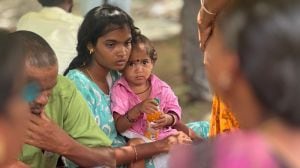Stay updated with the latest - Click here to follow us on Instagram
Amreli flood: Even as compensation eludes them, farmers pick up pieces
The survey of loss of crop and soil-erosion has been completed and the agriculture department is compiling the data.
 Ashokgiri Goswami tills his land as his wife Rekha looks on at Shedhavadar village in Amreli
Ashokgiri Goswami tills his land as his wife Rekha looks on at Shedhavadar village in Amreli
FIVE WEEKS after flash floods triggered by heavy rains ravaged parts of Amreli district, farmers are still trying to come to terms with their losses and picking up the pieces. However, the “delay” in awarding compensation for crop loss and soil-erosion is only dispiriting an agrarian life seeking a new beginning.
Bhupat Kansagra (45) and his younger brother, Magan, are plucking up weed grown up in an uncultivated corner of their agricultural field shadowed by a crumbled railway bridge in Vankia village of Amreli taluka. Bhupat’s buffalo is grazing on a portion of railway embankment and his daughter, Geeta, is looking after it. In a shanty, made of streel-sheets with pieces of roof-tile strewn around, Bhupat’s wife, Champa, is cutting vegetables. “This is the only work left for us after the flood. Our cottages, four buffaloes, a pair of bullock and dozens of mango trees have been washed away. You can see that sand has replaced soil in parts of our eight bigha land. We have not received any compensation from the government so far. I am a man with limited resources and restoration will take time,” Bhupat says. The farmer further says that buffaloes were his main source of income but they are gone. “This buffalo was also washed away in Shetrunji river.
[related-post]
After three days, we could locate her from a downstream village,” Narsinh says, pointing to out to the grazing animal. Champa breaks down while talking about the flood. “We have lost everything?our house, our cattle, our trees. We are now at the mercy of God,” she says.
The two brothers have sown jowar to provide fodder for two buffaloes which have survived. However, Manu Timbadiya and his brother, the residents of Vankia, have not been able to do sowing in large parts of their 42-bigha land. A mangled railway track of Amreli-Dhari section is lying in the middle of his field, covered with sand. Water of flooding Shetrunji had washed away railway embankment and metal spread in Timbadiya’s field. It also dragged the rails scores of metres away. “I don’t know when they are going to remove this railway track from my field. I can only level my land and think of sowing after it is removed,” says Tibadiya, who also lost his two farm cottages to the flood.
While Kansagra and Timbadiya have tried to overcome the devastation caused by the flood, Timbadiya’s neighbour, Sanjay Kansagra, is struggling. Sanjay has three bigha of land, but no sowing has taken place. “We lost our house, household articles and our elephant-like buffalo. We don’t have money to do anything now. My husband worked on Timbadiya’s farm to remove metal and the former has helped till our land by his tractor. We shall think of sowing something after we have money to buy seeds,” Sanjay’s wife, Asha, says while sitting on the debris of their pukka house, which collapsed during the flood of June 24. She adds that her family has not received any assistance from state government till date.
In downstream Liliya taluka, the situation is no better. Ashokgiri Goswami (42), a farmer of Shedhavadar village of Liliya, is tilling the soil between two furrows of tuvar while his wife Rekha is removing weed. But there are scattered plants of cotton also.
“I sowed cotton twice after the flood. But this fine sand which flood waters brought is not allowing to grow it. Now I have given up on cotton and tried tuvar as I am penniless and therefore cannot remove sand from my field,” says Goswami.
Shedavadar is a village located on the bank of Shetrunji. On June 24, the river breached its embankment between Shedhavadar and Loki villages and flooded the village and eroded land on either side.
“Even if I restore my land by borrowing money, there will be no use as my field will be prone to such erosion until the embankment is repaired,” Goswami adds. However, farmers with larger tracts of land have taken the risk. “Out of my 70 bigha of land, 55 bigha suffered soil erosion. However, due to my image in the society and with the help of relatives, I deployed two earth-movers and half a dozen tractors to restore it. But 40 bigha is still not cultivable. The government has surveyed the loss, but I am yet to receive any compensation,” says Ghanshyam Bhuva, a farmer of Bagasara.
Incidentally, Bagasara, Amreli and Liliya were among the worst-affected talukas of Amreli. Amreli District Collector Hargovind Suthar concedes many farmers are yet to receive compensation.
“The survey of loss of crop and soil-erosion has been completed and the agriculture department is compiling the data. The process is very much under way and we have disbursed approximately Rs 12 crore to farmers towards compensation for crop loss and soil erosion. Around Rs five crore has been paid against the loss of livestock,” the collector said.







